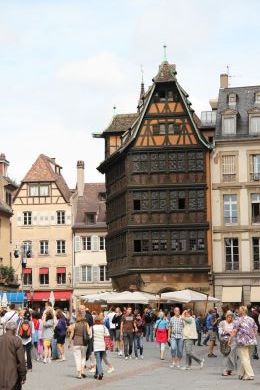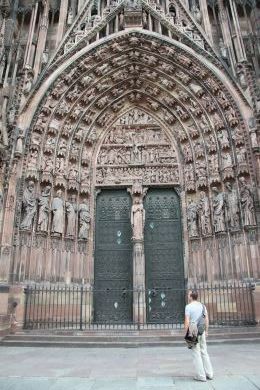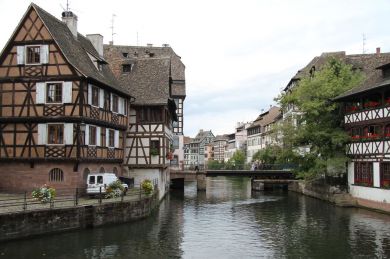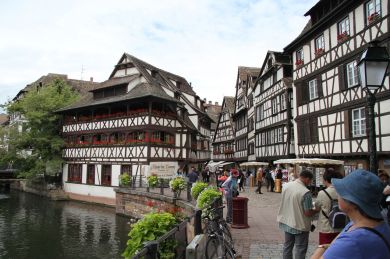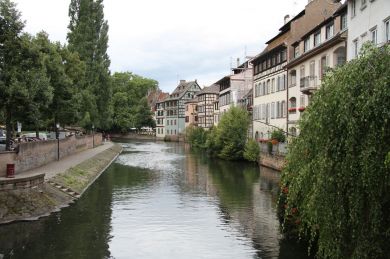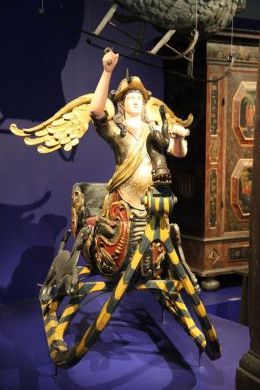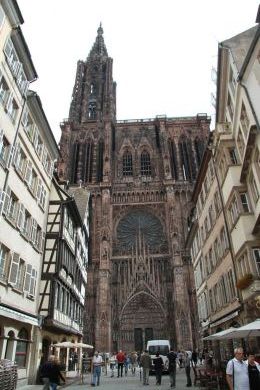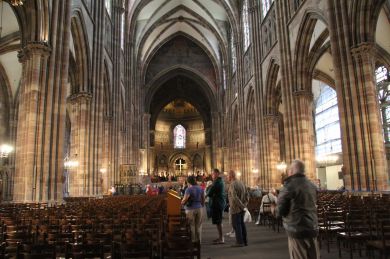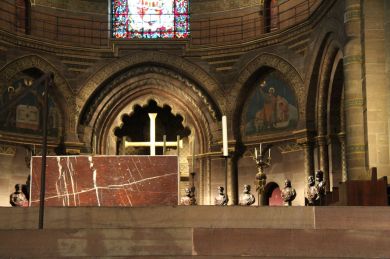Strasbourg
We had looked forward to spending time in Strasbourg and it did not disappoint us. The city is very accessible from the canals (and also served by excellent public transport and bike paths) and a good size to explore. There are impressive, stately buildings and many others that are very colourful, with many old half-timbered houses. Strasbourg is the capital of Alsace. As this whole area has changed nationality many times, its identity as "Alsace" seems to be very important. It went from being a Sovereign state, minting its own coins and maintaining and equipping an army, to being French (1681). Then in 75 years its nationality changed four times: annexed by Germany after the Franco-Prussian war, regained by France after World War 1, annexed by Germany at the beginning of World War 11 then back to France after that war. The war memorials in Alsace remember those who have died in war, either in the German or French armies. The architecture was different from what we have become used to in the rest of France as much was built when it was independent or German. Also, at the crossroads of Europe there would always have been a variety of influences. The three highlights for us were the Cathedral in pink sandstone with beautiful 12th to 14th century stained glass including a beautiful rose window; the canal area of "Petite France" with well-kept old and colourful houses made more attractive by the masses of flowers in their window boxes; and the impressive new architecture of the European institutions including the Palace of the European Parliament and the Court of Human Rights.
These are built along the Canals so we had a great view of them from the water. Vaubun the fortifier had been active in Strasbourg as well. He built a dam whose walls still survive, to serve as an extra protection for the city.
There is quite a lot of German spoken in Alsace- not surprising given the history. Other places we have been in France, French has been the only language spoken.
On leaving Strasbourg we entered a new canal, the Canal de la Marne au Rhin (which, as its name suggests, goes from the Marne River to the Rhine River), much of it in Alsace and built in the first half of the 19th century. We will be travelling along this Canal as far as Nancy this year, no doubt joining it again in later travels. So far it is a very pleasant canal with mainly automatic locks. There is a great deal of traffic, much of it from rental boats. It has so far offered many convenient places to stop along the banks, frequently with bollards or rings and sometimes with electricity and water.
Our first main stop was at Saverne which has an enormous palace, built and rebuilt first by the bishops of the area and later completed by Napoleon 3rd. It is in public hands and houses a museum and also a youth hostel, and the massive park is also open to the public. Saverne has a number of very attractive gardens including an interreligious garden developed by the Christian, Jewish and Moslem communities, with plants and landscapes symbolic of each faith tradition, but emphaising also their commonality.
Further along the canal and before the summit we stopped at Lutzelbourg which is at the junction of five valleys. We walked through quite dense forest up to a ruined chateau built of the attractive pink sandstone we had first seen in Strasbourg's cathedral. In amongst the chateau ruins we also noted the entry to a 10th century chapel. The view from the chateau over the five valleys made the stiff climb worthwhile.
Photos show:
Old Alsacian House
Cathedral doors
Petite France (x3)
Astronomical clock
Museum
Suburban House
Town Square
Cathedral
Streetscape
Cathedral (x2)
Best Regards,
Penny and Dave
